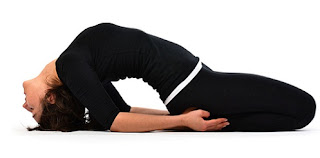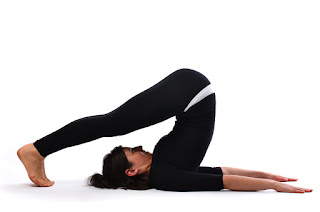Can yoga be helpful for thyroid treatment?
The body’s metabolism is regulated by the endocrine system, particularly the thyroid gland. Yoga for hypothyroidism is considered to be effective as it has a positive effect on the organs of the endocrine system, especially by stimulating the parathyroid and thyroid glands.
Thyroid Disease:
The thyroid or endocrine glands consist of two connected lobes. The thyroid gland is found in the neck, below the thyroid cartilage(which forms the Adam’s apple). The thyroid gland controls how quickly the body uses energy, makes proteins, and controls how sensitive the body is to other hormones. It participates in these processes by producing thyroid hormones, the principal ones being triiodothyronine (T3), and thyroxine (sometimes referred to as tetraiodothyronine (T4)). These hormones regulate the growth and rate of function of many other systems in the body. T3 and T4 are synthesized from iodine and tyrosine. The thyroid also produces calcitonin, which plays a role in calcium homeostasis.
HYPERTHYROIDISM:
People can suffer from hyperthyroidism. An overactive thyroid is defined as an overproduction of the thyroid hormones T3and T4.
This condition is most commonly caused by the development of Graves’ disease, an autoimmune disease in which anomalous antibodies stimulate the thyroid to secrete excessive quantities of thyroid hormones.
The disease can progress to the formation of a toxic goiter as a result of thyroid growth in response to a lack of negative feedback mechanisms.
It presents with symptoms such as a thyroid goiter, protruding eyes (exophthalmos), palpitations, excessive sweating, diarrhea, weight loss, muscle weakness, and unusual sensitivity to heat. The appetite is often increased.
HYPOTHYROIDISM:
People can also, suffer hypothyroidism. Hypothyroidism is the underproduction of the thyroid hormones T3 and T4. Hypothyroid disorders may occur as a result of
#Congenital thyroid abnormalities
# Autoimmune disorders such as Hashimoto’s thyroiditis,
# Iodine deficiency
# The removal of the thyroid following surgery to treat severe hyperthyroidism and/or thyroid cancer.
Typical symptoms are abnormal weight gain, tiredness, baldness, cold intolerance, and bradycardia. Hypothyroidism is treated with hormone replacement therapy, such as levothyroxine, which is typically required for the rest of the patient’s life.
Yoga for Thyroid Problems
Practicing Yoga for thyroid problems is a natural way to get rid of this medical condition. By practicing yoga regularly, you see normalcy in the production and release of the thyroid hormone. This ensures you reduce the dependency of thyroid medication. However, before starting any physical activity or exercise, always consult a physician.
Here is a list of 5 thyroid exercises you can follow to get rid of hypothyroidism/hyperthyroidism:
1. Sharvangasana (Shoulder Stand Pose) –
Method: Lying on the back with the hands under the mid-back, the legs and lower body are lifted so that the weight of the body is supported on the head, neck, shoulders, and upper arms. The gaze is towards the toes and the sagittal and transverse line of the head is perpendicular with the midsagittal and mid-frontal line of the body.
Caution: The asana is contraindicated for high blood pressure, whiplash, menstruation, angina, and spinal weakness caused by conditions such as arthritis or osteoporosis. The weight placed on the cervical spine may mean a risk of a neck injury, particularly if the asana is not done properly.
2. Matsyasana (Fish Pose) –
Matsyasana (Fish Pose) is a back-bending yoga posture that opens the chest, throat, and abdomen. It is usually used as the counter-pose to Shoulderstand (Sarvangasana) because it neutralizes pressure on the neck and spine, but it is also a deep stretch with many benefits in its own. The name of the posture derives from the fact that if you adopt the position in the water, you will float quite easily. Try to hold the pose for half of the time that you spent in the Shoulderstand, in order to equalize the stretching effects on your spine and muscles.
Method: Lie down flat on your back. Bring the feet together. Place your hands with palms turned down beneath the thighs close to the buttocks. Then lift the chest up by pushing the elbows into the ground. Once your chest has been lifted above the ground as high as possible, gently drop the head back so as to touch the floor. Try to remain in the position for one minute or so.
Benefits: The Matsya bandha causes a stretching on the thyroid and parathyroid glands. Matsyasana is all about stretching your lower body. It helps in burning extra fat on the thighs, hips, and lower abdominal area.
Caution:Should not be performed by people suffering from high blood pressure, heart diseases, hernia, or ulcers. You should avoid it during menstruation and pregnancy.
3. Halasana (Plough Pose) –
Method: For doing this asana,lies on the floor, lift the legs, and then place them behind the head. Experienced practitioners may enter Halasana from a standing position by tucking the chin to chest, placing hands on the floor, walking the feet towards the hands and bending at the elbows to lower shoulders to the floor.
4. Bhujangasana (Cobra Pose) –
Method: Lie on the stomach with feet together and toes flat. Place the hands downwards below the shoulders on the mat, lift your waist, and raise the head while inhaling in. Pull the torso back with the support of hands. Keep elbows straight and make sure to put equal pressure on both palms. Tilt the head back and make sure the shoulders are away from the ears. Exhale while coming back to the ground.
Benefits: This pose causes a stretching on the thyroid and parathyroid glands. It brings a uniform arch in the spine, increases blood circulation to the thyroid gland, boosts muscle quality, and flexibility around the gland.
5. Dhanurasana (Bow Pose) –
Method: First lie prone and grasp the feet to lift the leg and chest to form a bow. Remain in this position for some time and then return to the previous position.
6. Ustrasana (Camel Pose) –
Method: To get into the position, begin in a high kneeling position with your palms pressing into your low back to support the spine. Tuck the toes under, or press the tops of the feet into the floor as you press your pelvis forward and lift your belly. As you move farther into the backbend, lift the chest, and allow the head to follow, without letting the head fall all the way back. To move into the full variation of the pose, reach your arms back to touch your heels. When you are ready to release the pose, draw your palms back to your low back and lead with the chest as you rise back up.
Caution: Don’t collapse in your neck area, so that the blood vessels that bring blood and oxygen to the brain are not compressed, otherwise you may feel dizzy, get unstable and the overall posture becomes unsafe. Practicing Ustrasana can make many beginners new to yoga feel distinctly ill, with lightheadedness or nausea being quite common after-effects. However, this does usually improve with practice.
7. Setu Bandh (Bridge Pose) –
Method: For doing this asana, lie down on your back and bend your knees so that your feet rest on the floor. Keep the same distance between your feet and buttocks as your hands. Now, try to lift your body in an upward direction. Do this 5-10 times & then release. This works wonders on your hips, thighs, stomach as well as back.
Benefits: This asana increases blood supply to the thyroid gland and thereby supplying essential nutrients to the gland.
These asanas have been performed by a trained yoga instructor.





